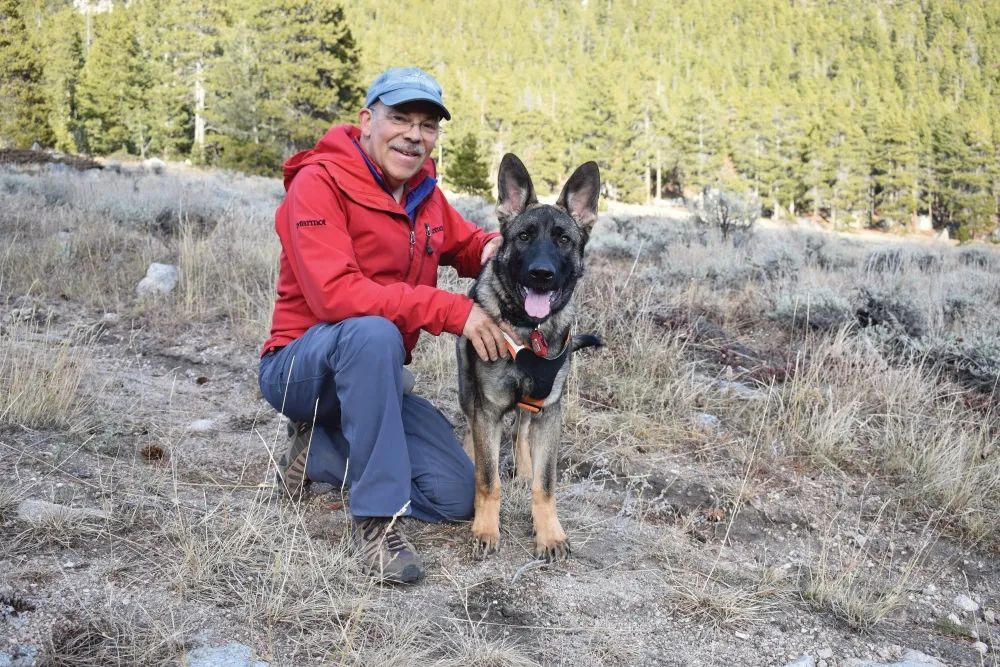
The Dog’s Nose… Knows
February 2022
article & photos by stephanie hobby
A slight breeze moves through the cool mountain air as Alpine, a not-quite 6-month-old German Shepherd, clambers out of the truck into the sagebrush below. You can sense his excitement - he knows it's time to play. But his playtime couldn't be more serious. Alpine is training to be a search and rescue dog. His handler, Mark Polakoff, volunteers with Absaroka Search Dogs and the Red Lodge Fire Rescue Search and Rescue team and is an avid outdoorsman, a former ranger at Yellowstone National Park, and a registered nurse at Billings Clinic. Together, Alpine and Polakoff will eventually scour terrain across Montana and Wyoming, racing the clock to find the lost and injured.
Today is a bit more leisurely. Alpine is Polakoff’s sixth search and rescue dog, so they’re running through his routine drills and playing games, earning trust and learning to read one another’s cues. Dogs’ remarkable senses, combined with a people-pleasing nature and intense drive, make them ideal partners in search and rescue efforts. That bond between dog and handler is critically essential for a successful team, but it takes time to develop. It's typically two or three years before a dog is ready to venture out into unfamiliar territory and put their incredible senses to work.
Superheroes have nothing on canines. Dogs’ hearing is two to three times more sensitive than ours, and their paws can detect unstable ground, a lifesaving feat when potential avalanches threaten a mission.
But the real magic starts at the end of their snouts.
“Nobody knows exactly how sensitive dog noses are,” Polakoff said. “We smell parts per million, so when you smell a swimming pool, that’s somewhere around one to three parts per million of chlorine. Dogs, we think, can smell parts per quadrillion. To give you an idea of what that looks like, you could take a drop of human scent, and put it on a seat in a professional football stadium, and the dog could not only find it, but if they were trained properly, could differentiate it from other drops of human scent.”
So incredible is this capability that the Department of Defense tried for years to replicate it by building an artificial bomb-sniffing device. After nearly $20 billion and over a decade of research, the military went back to employing man’s best friend.
Polakoff wasn’t surprised. In the late 1990s, his friend went looking for a drowning victim at Priest Lake, and the dog picked up the scent. Using submersible cameras, recovery workers found the victim at the lake's bottom, some 350 feet down. It would have been a pretty standard operation had the victim drowned recently. But the victim had drowned in the 1850s, nearly 150 years earlier.
So what’s behind this unfathomable ability? If you have a dog, hold out a treat and watch their nostrils. Their noses seem to move back and forth. What’s happening is that each nostril works independently. This allows dogs to smell in 3-D, sussing out which side offers the stronger scent, a technique that enables them to follow a twisting trail. The comma shape of the nostril also comes into play. A dog inhales through the larger, round opening while exhaling through the narrower sides, keeping the scent from being diluted on the exhale.
Once an aroma makes its way into the nose, it’s immediately met by a dense network of nerves. Veterinarians believe dogs have between 100 and 300 million olfactory receptors, compared to six million in humans. Put another way; if a dog's vision was as powerful as its nose, it would be able to see at 3,000 miles with the same clarity as what we see from a third of a mile! Furthermore, the part of their brain devoted to analyzing scent is 40 times bigger than ours, so they can quickly determine what’s relevant. Polakoff likens it to smelling apple pie in a bakery. When dogs analyze the same scent, they'll get individual apple, butter, cinnamon, and flour notes.
Thankfully, dogs can pick apart human scents too. You're actually very messy, no matter how clean you think you are. Every minute, you shed up to ten thousand cells, leaving an invisible trail of biological trash, imprinted with your signature scent, everywhere you go. The soap you use, the foods you eat, what you drink, bacteria on your skin, and how much stress you're under all make up your particular aroma.
Two basic ways dogs find people are air scenting and tracking or trailing. Dogs who are air scent trained can follow gaseous and liquid trails. For drowning victims, most human scent is lighter than water; it will float to the surface, where it vaporizes and floats away in the air; trailing or tracking dogs work with their noses to the ground. There are a few subspecialties, including air scenting for live people, air scenting for cadavers, air scenting in water, avalanche, tracking or trailing, and even evidence, to look for crime scene clues. Each one requires separate training and certification tests.
Alpine will eventually be certified in several subspecialties. Dogs tend to focus on one specialty in other parts of the country, where there might be hundreds of available teams. In Montana, though, with fewer than 30 certified search dog teams who might have to travel hours to reach the search, it pays to have a well-rounded animal who can cater to various needs.
And while it’s exhausting work, at the end of the day, Alpine is perfectly content to settle in with his toy and praise. For Polakoff, it’s a commitment to helping people. “I grew up in an apartment, and never had a dog. I always wanted to get a dog, and when I was finally able to get one, I was pursuing my interests in outdoor recreation,” he said. “I was with the outdoor programs at the university, teaching people outdoor skills, and in sort of a larger picture, I had the feeling that someone might get in trouble because of the skills I introduced them to. That was what drew me to this lifestyle.”
Originally printed in the February 2022 issue of Simply Local Magazine
Never miss an issue, check out SLM's digital editions here!





